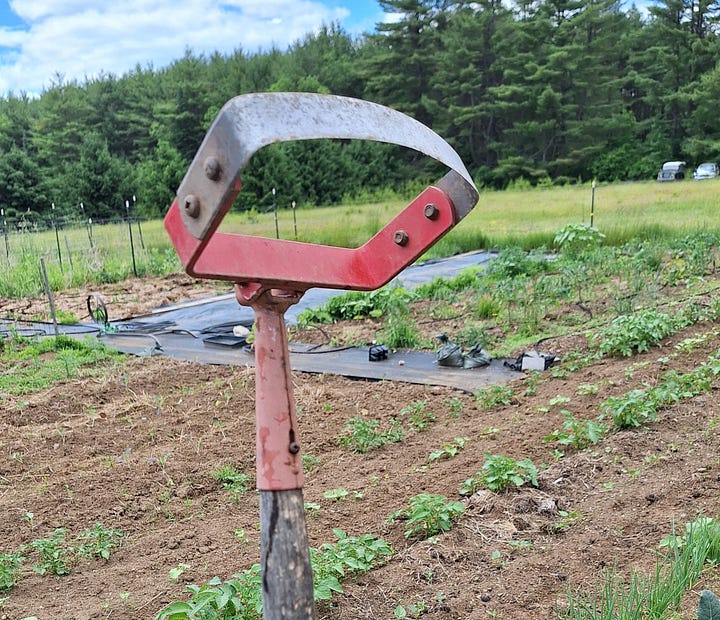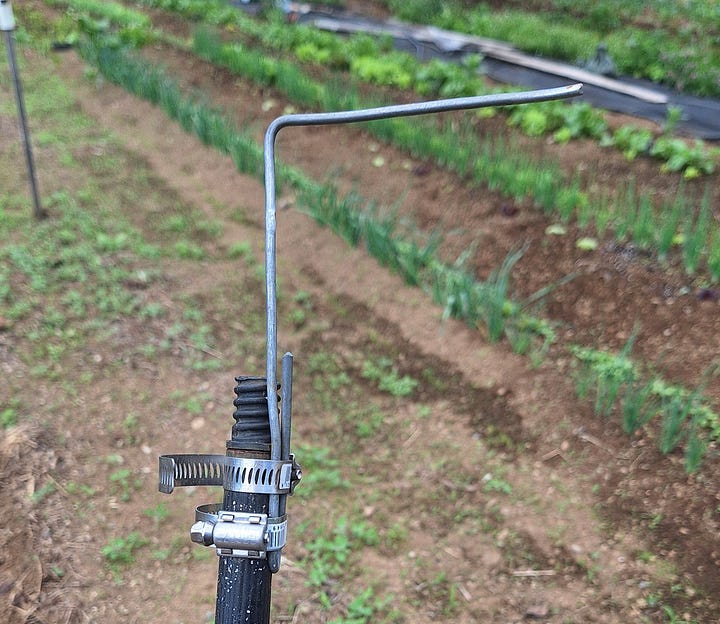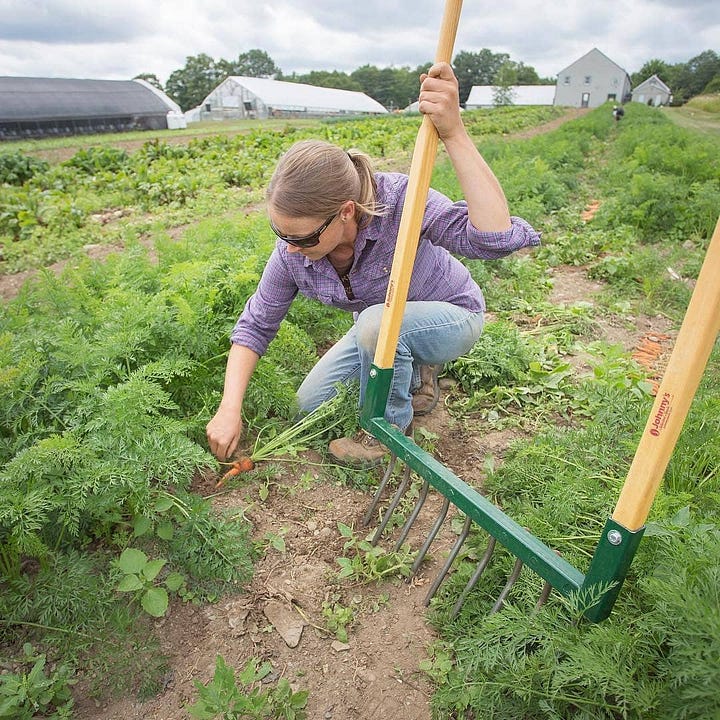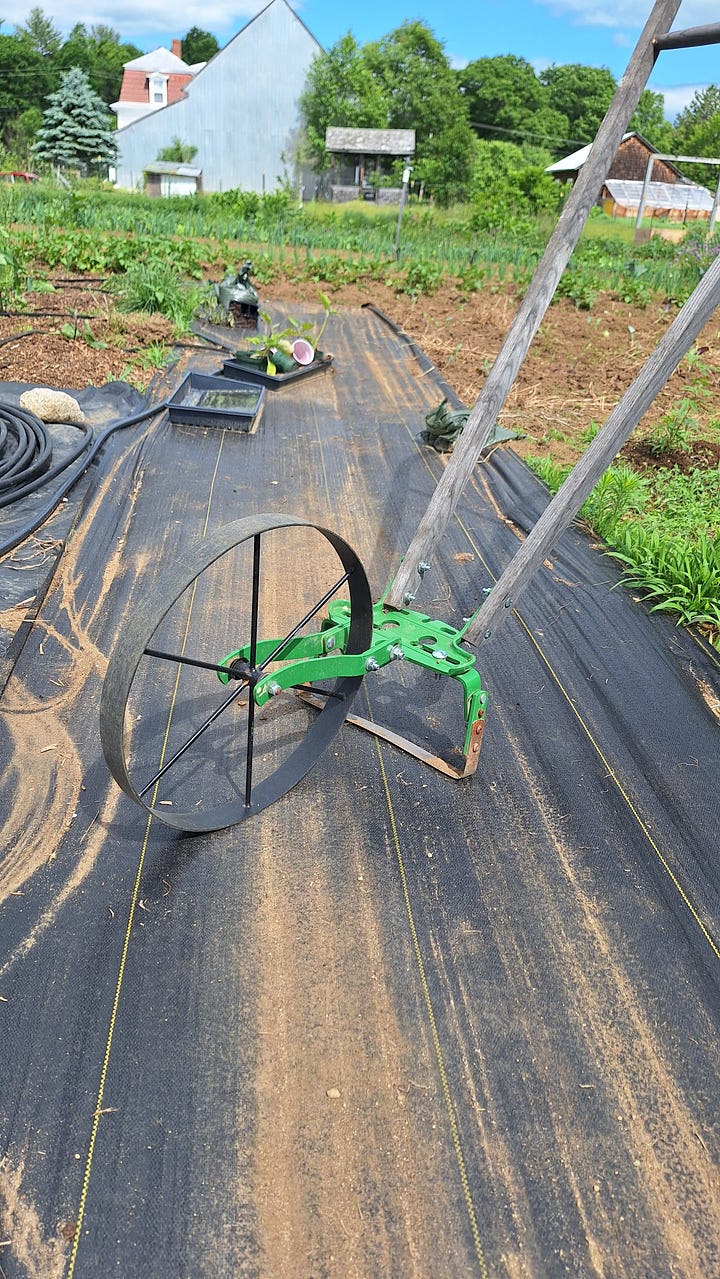Whacked Out: Weed-Whacker Wars at Runamuk
In spite of the barriers, the data shows that no-till farming adoption has been steadily increasing
Frustrated, I searched in vain for the small spring in the tall grasses and clover. The head of the weed-whacker had come apart mid-use—spool and trimmer line went one direction, spring went another. Who knew how far it was flung—but I was desperate to find it.
The heavy duty Powersmart 31cc 4-stroke weed-whacker is an invaluable tool for this no-till farm. Without it, the vegetable garden is a lost cause, already overgrown with weeds after my late-start this season…
Welcome to the latest Updates From the Farm! If you are new here, I invite you to check out my About page to learn what this is, who I am and why I am doing this. Or just dive right in! At “Runamuk Acres” you’ll find the recantings of one lady-farmer and tree-hugging activist from the western mountains of Maine. #foodieswanted
In This Post:
Weed-Whacker Wars
In Other News
Community Updates
Getting Intimate With Soil
➡️NOTE: I’m trying something new this week! Striving for shorter posts with more focus on one select story to be published weekly on Saturday mornings. Share your thoughts at the bottom!
Weed-Whacker Wars
It’s a beast of a weed-whacker, bought for me by my last serious boyfriend, and I absolutely love this tool.
On this farm, I use it to protect my burgeoning orchard—keeping grass down around young fruit trees deters deer and beetles.
I use it to maintain fence-lines to keep my sheep where I want them.
And I use it extensively in my no-till garden.
CHALLENGES OF NO-TILL
Weeds are one of the most common concerns with no-till agriculture—and I’m not gonna lie, it’s a challenge.
Mulching can significantly reduce weed-pressure. But the thing no one mentions is that mulching takes a tremendous amount of material, time and energy to cover a sizable garden, and if you lay too little, weeding becomes a nightmare.
So what do you do without the man-power or money for vast quantities of mulch?
Some no-till farmers use wide aisles which they mow, only mulching the actual garden beds.
Most of my paths, however, are 12-inches wide—24 around the perimeter. They’re too narrow to mow.
Instead, I maintain pathways with the wheel hoe or stirrup hoe. And, if things get away from me, it’s much more work to reclaim those pathways.
Once the pathways fill with weeds, they spread into my beds, choking out crops and creating inviting habitat for uninvited dinner guests. Insects, birds and deer all love an overgrown and neglected garden.
OVERRUN
That’s exactly what I’m up against this season.
Between work at school and frequent rains, the garden has become overrun with weeds. When the weather and my schedule finally lined up, I took my trusty beast of a weed-whacker out to the garden—only to have the head come apart mid-use.
Calling PowerSmart’s customer service was a lesson in futility, highlighting the corporate mindset driving our industries. They’d rather you buy a new machine than repair the one you have.
Universal parts won’t work on this model, I was told—and they promised a call back after the rep “searched for parts”.
Impatient and worried about loosing what little I’ve managed to plant, I spent precious hay-funds on a new Ryobi weed-whacker.
FEELING FOOLISH
For years I’ve been a proud “Ryobi-girl”. A good mid-range brand, Ryobi tools have always served me well.
Unfortunately, this weed-whacker was a huge disappointment—impossible to start and overheating in no time.
Out $210 and feeling foolish, I called PowerSmart again. This time I was told the company rarely has parts available and was instructed to use any replacement part that fits.
After all that run around, I stopped by the local hardware store and picked up a replacement head for $38, brought it home and successfully install it onto my weed-whacker without issue.
$250 and 2 weeks later, I’ll be in the garden this weekend for as long as my muscles will support the work. Foolish or not, I’m still clinging to hope for a fall harvest.
➡️Read more about the benefits and challenges of no-till farming.
In Other News
IMPENDING HAY HARVEST!
This week we received word from our hay farmer at Hyl-Tun Farm in Starks of the impending hay harvest. Getting all of the pieces lined up to bring a bulk-load of hay from the fields 15 miles away to Runamuk is a feat in itself and I’ve been stressing about making sure things go smoothly.
➡️Stay tuned for more on Hay Mission 2025 in next week’s update!
ADVENTURES IN WRITING
Since it is my goal to replace all off-farm income with income derived from writing, I’ve been hyper-focused on building my writing career. This week, I created an author website to showcase my skills: Samantha Burns Writes
And guess what!
I received my first paying writer-gig this week, plus a new paid subscriber. Both bringing a healthy dose of hope for what lies ahead.
I’m grateful and cling to that hope like a lifeline.🙏
Community Updates
IN CASE YOU MISSED IT
➡️The first issue of my new newsletter, Eco-Farm Strategies went out this week. You can view that here: Work WITH Nature—Not Against It
HARVEST HUB
➡️Don’t forget about this month’s Harvest Hub this afternoon at 2pm EST. Paid subscribers will see an invite in your inbox.
Getting Intimate With Soil
In spite of the barriers, the data shows that no-till farming adoption has been steadily increasing—on wheat acres, no-till increased from 20 percent in 2004 to 45 percent in 2017, and for corn acres, no-till increased from 16 percent in 2001 to 36 percent in 2021.
I admit it’s fairly intense physical labor—yet, I revel in the activity.
It’s good for me and it’s good for YOU. No-till is good work for the body—and good for our mental health, too.
PRO TIP: A stretch of sunny, hot days is ideal for reclaiming overgrown beds and pathways with hand-tools.




The sun and heat reflects off the soil into my face as I work.
A passing shower the night before left the landscape wet, and as the heat increases, so does the humidity—until it feels as though you’re swimming through the air.
Sweat drips off my nose into the soil below and the muscles burn with effort. Tunes blaring from the phone in my back pocket, I establish a rhythm and move briskly along the 50-foot beds.
Insects drone and buzz around me, while bluebirds dip in and out of the garden.
Getting intimate with soil like this, I can’t help feeling so alive—and supremely grateful just to be part of this amazing world upon which we are fortunate enough to live.
Our very existence is a marvel.
As always—no matter how you subscribe, I thank you just for reading.
Sending love and good juju to you and yours.
Your friendly neighborhood farmer,
Sam
✨One Last Thing…
Research shows that sharing your farm's story online can boost sales conversions by 30%, which is why I'm offering ghostwriting services that combine my skills as both a writer and farmer. Together, we can create authentic, compelling farm stories that resonate with customers and drive sales for your operation. Hire me to write for you.
Thank you for following along with the story of this lady-farmer! It is truly a privilege to live this life serving my family and community, and protecting wildlife through agricultural conservation. If you found this valuable, please consider Restacking so more people can see it!






Kudos to you! The post did not seem short to me at all. You could keep it briefer to save time.
So few farmers care about supporting the soil first, and no-till methods. I kept two weed-whackers when I farmed. Mainly because the price of a replacement battery was almost the same as the whole device that came with a battery included. That way I always had one fully charged. I know how hard you are working. Have you thought about teaming with other farmers as a coop to share the land?
Your new format is so reader friendly and fun. Nicely done!😊